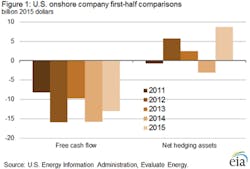Second-quarter results for U.S. onshore oil producers suggest continued financial strain for some companies, according to the U.S. Energy Information Administration.
With U.S. crude oil prices 47 percent lower in first-half 2015 compared to first-half 2014, U.S. companies with onshore oil operations experienced a significant reduction in cash flow from operations. To adjust to lower cash flows, companies have turned to capital markets financing and also have reduced capital expenditures. With energy company bond yields widening in relation to U.S. Treasury bonds, some companies may have to reduce capital expenditures further to service their debt, EIA says.
The 44 companies analyzed contributed much of the growth in global oil production over the past several years. Most of their operations are focused in onshore shale plays in the United States. According to the financial statements, their combined production averaged 2.7 million barrels per day over the first half of 2015, representing approximately 35 percent of U.S. Lower 48 production.
READ ALSO: EPA Proposes New Measures to Cut Methane Emissions from Oil and Gas
Even before the decline in prices, these companies had typically used a combination of debt, new equity, and cash flows to finance their rapid expansion, which is a common strategy for growing companies that need to finance investment before operating cash flow can increase. The difference between operating cash flow and capital expenditure—known as free cash flow—remained at a deficit in first-half 2015, although it was $2.8 billion higher than the same period in 2014 (Figure 1) and the second quarter was the lowest deficit for any quarter since 2012.
In addition to reducing capital expenditures, this group of companies responded to the reduction in cash flow in the first half of 2015 through share and debt issuance. Some companies have been able to refinance their debt—that is, paying off old debt and taking on new debt, perhaps with a different interest rate or longer maturity. This option has increasingly become more expensive, though, as interest rates for energy company debt issuance increased as crude oil prices declined, and are higher than for any other business sector.
Further analysis can be found in EIA’s "This Week in Petroleum" report.



